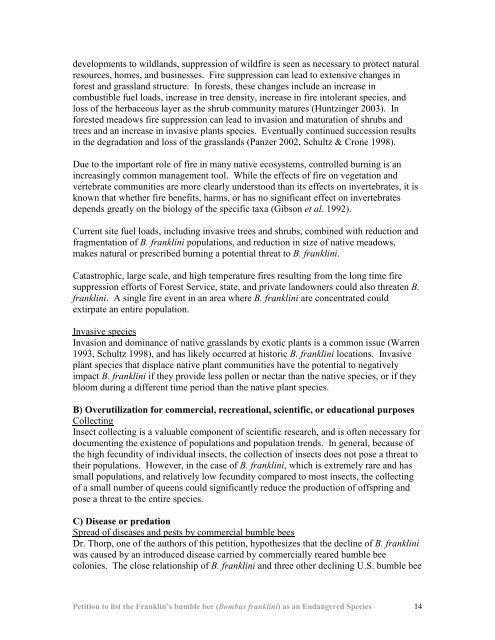Franklin's bumble bee - The Xerces Society
Franklin's bumble bee - The Xerces Society
Franklin's bumble bee - The Xerces Society
You also want an ePaper? Increase the reach of your titles
YUMPU automatically turns print PDFs into web optimized ePapers that Google loves.
developments to wildlands, suppression of wildfire is seen as necessary to protect natural<br />
resources, homes, and businesses. Fire suppression can lead to extensive changes in<br />
forest and grassland structure. In forests, these changes include an increase in<br />
combustible fuel loads, increase in tree density, increase in fire intolerant species, and<br />
loss of the herbaceous layer as the shrub community matures (Huntzinger 2003). In<br />
forested meadows fire suppression can lead to invasion and maturation of shrubs and<br />
trees and an increase in invasive plants species. Eventually continued succession results<br />
in the degradation and loss of the grasslands (Panzer 2002, Schultz & Crone 1998).<br />
Due to the important role of fire in many native ecosystems, controlled burning is an<br />
increasingly common management tool. While the effects of fire on vegetation and<br />
vertebrate communities are more clearly understood than its effects on invertebrates, it is<br />
known that whether fire benefits, harms, or has no significant effect on invertebrates<br />
depends greatly on the biology of the specific taxa (Gibson et al. 1992).<br />
Current site fuel loads, including invasive trees and shrubs, combined with reduction and<br />
fragmentation of B. franklini populations, and reduction in size of native meadows,<br />
makes natural or prescribed burning a potential threat to B. franklini.<br />
Catastrophic, large scale, and high temperature fires resulting from the long time fire<br />
suppression efforts of Forest Service, state, and private landowners could also threaten B.<br />
franklini. A single fire event in an area where B. franklini are concentrated could<br />
extirpate an entire population.<br />
Invasive species<br />
Invasion and dominance of native grasslands by exotic plants is a common issue (Warren<br />
1993, Schultz 1998), and has likely occurred at historic B. franklini locations. Invasive<br />
plant species that displace native plant communities have the potential to negatively<br />
impact B. franklini if they provide less pollen or nectar than the native species, or if they<br />
bloom during a different time period than the native plant species.<br />
B) Overutilization for commercial, recreational, scientific, or educational purposes<br />
Collecting<br />
Insect collecting is a valuable component of scientific research, and is often necessary for<br />
documenting the existence of populations and population trends. In general, because of<br />
the high fecundity of individual insects, the collection of insects does not pose a threat to<br />
their populations. However, in the case of B. franklini, which is extremely rare and has<br />
small populations, and relatively low fecundity compared to most insects, the collecting<br />
of a small number of queens could significantly reduce the production of offspring and<br />
pose a threat to the entire species.<br />
C) Disease or predation<br />
Spread of diseases and pests by commercial <strong>bumble</strong> <strong>bee</strong>s<br />
Dr. Thorp, one of the authors of this petition, hypothesizes that the decline of B. franklini<br />
was caused by an introduced disease carried by commercially reared <strong>bumble</strong> <strong>bee</strong><br />
colonies. <strong>The</strong> close relationship of B. franklini and three other declining U.S. <strong>bumble</strong> <strong>bee</strong><br />
Petition to list the Franklin’s <strong>bumble</strong> <strong>bee</strong> (Bombus franklini) as an Endangered Species 14
















